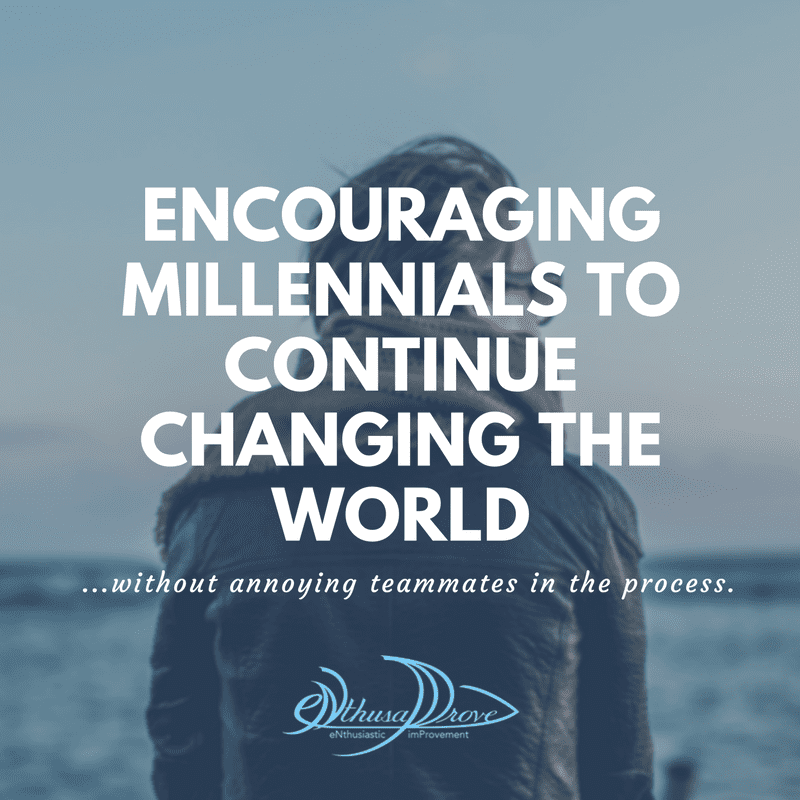 A decade-ish ago, the Millennial generation started entering the workforce. I am on the fringes of a Millennial, which some call xennials. I remember being one of the first “explorers” of the workforce before the Millennial tidal wave started rolling in the door and, by sheer numbers, changing the workplace. Now Millennials are starting to change leadership discussions because they are entering leadership positions. That’s what I’d like to talk about today, Millennials and leadership.
A decade-ish ago, the Millennial generation started entering the workforce. I am on the fringes of a Millennial, which some call xennials. I remember being one of the first “explorers” of the workforce before the Millennial tidal wave started rolling in the door and, by sheer numbers, changing the workplace. Now Millennials are starting to change leadership discussions because they are entering leadership positions. That’s what I’d like to talk about today, Millennials and leadership.
Often, Millennials are characterized by their abundance of optimism and drive to change the world. This is something the workplace knows we need, but there’s still this reserved frustration under the breath of established workplaces. So, this begs the question…
How do you encourage your Millennial leader to continue changing the world, without annoying teammates in the process?
Here’s a few stories that Paul and I have heard about in the last week (yes, just a week) that made us think that we needed to talk about this.
Scenario 1: Marketing Executive Meetings
A consultant we work with was sharing how her daughter, a marketing executive, will run meetings and receive complaints that the meetings were unfocused and unproductive. Her team gets disillusioned that meetings are useless and a waste of time. When her mom (who was a very successful manager and then consultant) hears this, she asks about agendas, establishing the purpose of the meeting…to which her daughter sort of shrugs that off.
Scenario 2: The New Self-Help. The Rise of Jordan Peterson & Rachel Hollis
Jordan Peterson is making waves all over the culture in the last 2 years, and has the #6 best selling book on all of Amazon, 12 Rules for Life. He is a deep academic that references research and more research to back up his claims. His #1 rule for life is to stand up straight with your shoulders back (which is of course scientifically based claim). Rachel Hollis has the #9 best-selling book, Girl, Wash Your Face which speaks to women about using very basic life-strategies to achieve big goals. Both of these speak to a very fundamental thing in the leadership space. It is the simple things of life that make the big difference.
Scenario 3: Senior Executive Plane Ride
Paul was flying home from a client site and had a friendly conversation with a senior executive. This executive shared that his younger workers seem to think that they can make their own rules about how long they work, when they work, when they show up at a meeting, etc. He is all for flexibility, so he made a distinction that to me was a great point.
“Don’t be changing the rules and making new ones until you first show that you’re part of the team and at least respect the rules that are in place when you signed on.”
This isn’t a conformist mantra, it is deeper than that. Established processes and rules were put in place for a reason. That reason may be out of date or obsolete, but when we understand and respect those reasons we build trust. No one changes the world without the trust of others. When people trust that you understand, change becomes less threatening. (That’s good advice for my fellow consultants.) Paul’s Senior Executive friend basically stated that he thinks it’d serve everyone better if these younger new hires would learn who and what the norms are before they throw them aside.
The three themes here show a theme that there needs to be a shift in how we approach leadership. Here’s the take-aways from each story.
- Respect other people’s time and attention. Be prepared and focused.
- It is the simple things of life that make the big difference.
- Don’t go changing the rules without showing respect to the established ones.
What does that say to you?
I see a theme that changing the big world without first mastering the small world that we can control (Personal Mastery) is a recipe for chaos and tension, maybe dissension. I believe that in the rush of daily life and the promise of technology solutions for everything, we lose a lot. We lose touch with how to interact with others, develop trust, and use that trust to do new things that make the world better. Turning the tide on this involves some basic attitudinal shifts, like a rudder on a ship. A small change at the right place makes huge differences in the effect.
This would make team trust, or, psychological safety, the overwhelmingly critical component to team success (which is backed up by research).
That requires the change agent to share their vision, connect others to the value and invite them to co-create the change. This is what we expect from any change leader, regardless of age or tenure.
Paul and I believe this speaks to a larger need for leaders to have simple guidelines to help them be successful. We may have gone out on a limb and touched a nerve here. I hope that many of you take some time to share your valuable thoughts, push back on the perspective I’ve shared, and maybe we can all see a way to be better team leaders, no matter our age or experience.
We put together thoughts and simple, tangible ways to engage your teams in this downloadable PDF.






